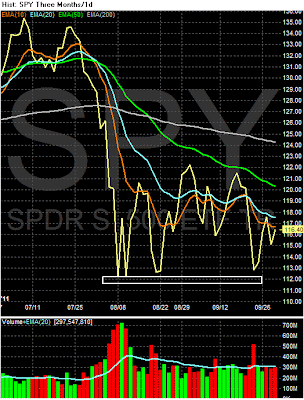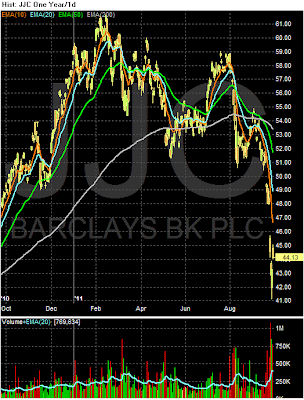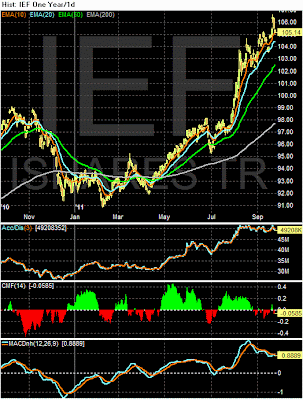- by New Deal democratMonthly data released this week actually wasn't gloomy. Housing permits, a leading indicator, were above 600,000 for the fourth month in a row. Existing home sales also beat estimates handily. Leading Indicators for August were reported up 0.3% (but see my discussion of money supply below). In the rear view mirror, in the second quarter households continued to deleverage and if the trend continues will be in their best position re debt servicing since before Reagan's presidency by next spring.
With the major exception that there are more signs housing prices as well as purchases have bottomed, and a few minor improvements, the
high frequency weekly indicators give no grounds for solace. In particular they do not bode well for the September jobs report.
Adjusting +1.07% due to the 2011 tax compromise, the
Daily Treasury Statement showed that for the first 15 days of September 2011, $103.8 B was collected vs. $104.5 a year ago, meaning that once again there was an actual decrease of $0.7 B. For the last 20 days, $128.8 B was collected vs. $129.1 B a year ago, for a decrease of -0.2%. That this has turned in a YoY loss for the second week in a row is ominous for the September jobs number.
The
BLS reported that Initial jobless claims fell 5,000 to 423,000. The four week average increased to 421,000. This remains unwelcome and also does not bode well for the September jobs report.
One recent source of good news, the
Money supply surge, may be ending. M1 declined -1.3% for the week. It remains up 1.4% m/m, and 20.9% YoY, so
Real M1 was up 17.1%. M2 also declined, down -0.1% w/w. It remained up 0.7% m/m, and 10.4% YoY, so
Real M2 was up 6.6%. The YoY increase in both M1 and M2 continue near historic high levels. To show you how important this surge has been, had there not been the record surge in money supply in August, the Leading Indicators for last month would have been reported down a very significant -0.4.
Oil finished at $79.85 a barrel on Friday. This is close to its lowest close in 24 months -- Oil was last below $75 a barrel in September 2009. West Texas Intermediate has declined by a full 1/3rd in price since its April high of $115. Gas at the pump fell $.06 to $3.60 a gallon. Gasoline usage was actually UP by a grand total of 0.1% YoY, at 8858 M gallons vs. 8847 M a year ago. This is only about the 4th time in just over 6 months that gasoline usage has been YoY positive. While measured as West Texas Crude, oil is about $15 below its recession trigger level, gas at the pump may be the better measure, and this is about $.30 above its inflation adjusted recession trigger level from 2007.
Weekly
BAA commercial bond rates rose .09% to 5.33%. Yields on 10 year treasury bonds only rose .04% to 2.03%. This continues the recent trend of increasing spreads between these two rates, as well as overall weakness, and so indicates a continuing slight increase in the relative distress in the corporate market.
The
American Association of Railroads reported that total carloads decreased -.3% YoY, down 1900 carloads YoY to 542,200. Intermodal traffic (a proxy for imports and exports) was up 2200 carloads, or 0.9% YoY. The remaining baseline plus cyclical traffic declined 4100 carloads, or -1.4% YoY. Rail traffic has been negative YoY for 6 of the last 11 weeks. Using the breakdown of cyclical vs. baseline traffic from
Railfax, baseline traffic was down 8400 carloads, or -4.2%YoY, while cyclical traffic was up 6500 carloads, or +1.9% YoY.
All is not gloom and doom. Several series were neutral or mixed.
Retail same store sales had another mixed performance. While the
ICSC reported that same store sales for the week of September 17 increased 3.4% YoY, and also increased 1.2% week over week,
Shoppertrak reported that YoY sales only rose 1.7% and declined -10.5% week over week.
The
American Staffing Association Index went back up again to 88. This series has completely stalled at the 87-88 range for 3 months.
In the longer term perspective, there is - relatively - good news coming out of housing, which shows more evidence of bottoming both in terms of purchases and sales, and also prices.
The
Mortgage Bankers' Association reported that seasonally adjusted purchase mortgage applications declined 4.7% last week. They did not report the YoY change, but a comparison with last year indicates a very slight decline. Purchase mortgage applications have essentially been flat for the last 16 months (which is an improvement over the previous 4 year decline). Refinancing increased 2.2% w/w with record low interest rates.
As to housing prices, YoY weekly median asking house prices from 54 metropolitan areas at
Housing Tracker showed that the asking prices declined -1.7% YoY. This is yet another record smallest YoY decline in the 5 year history of this series (YoY measurements were possible beginning in April 2007). . The areas with YoY% increases in price increased by one more to 15. The areas with double-digit YoY% declines decreased to only 2 -- Reno, NV and Chicago. If the current trend continues, nationwide asking prices will be YoY positive by the end of this year.
The weekly indicators this week once again are evidence that the economy is probably contracting slightly. In the longer term, that at long last, households are nearing their best position vis-a-vis debt in one-third of a century, and the housing market is showing signs of an actual tepid turnaround, are affirmation that This Too Shall Pass.
Have a nice fall weekend!








































